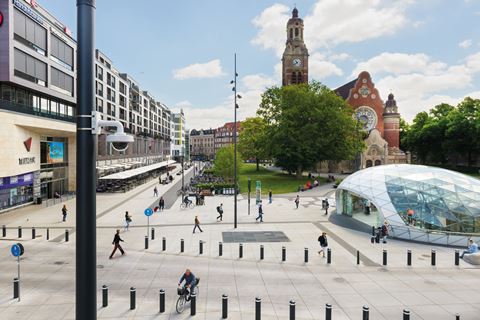Maintaining the safety and security of residents is a key objective for city officials. However, this can be difficult to achieve in cities that are by nature complex environments to monitor, due to the high level and variety of activity. On top of this, multiple incidents can occur within the same time frame, making it extremely challenging for authorities to monitor and maintain safety in all places at once. Here, Jerom Lemke, Global Product Manager at Axis Communications discusses how panoramic and PTZ camera solutions can help overcome some of these complex challenges.
Law enforcement officers are faced with the challenge of providing accurate details of where and how safety and security instances have transpired but the ability to accurately discern details may be missed due to the distance, as well as obstacles to line of sight. As a result, local security teams rely heavily on technology to help monitor areas and provide details on incidents.
Panoramic and Pan-Tilt-Zoom (PTZ) cameras are key parts of a surveillance solution, and there are a number of areas where they can add value. The first step to understanding their value is to identify the different attributes panoramic and PTZ cameras bring to the table.
The key advantages of panoramic cameras
Panoramic cameras provide wide-area coverage with just one camera. Security teams can use them to monitor activities and detect incidents in large areas, track the flow of people, and improve area management. With just one camera playing the role of many, installation and system costs are also kept lower.
Within the range of panoramic cameras available, there are unique capabilities and attributes. For instance, single-sensor panoramic cameras tend to be more suitable for smaller indoor areas such as shops or lobbies. The field of view is determined by where it is mounted. For example, when mounted on the ceiling these cameras provide a 360-degree view of the area. As well as giving a large overview, the latest panoramic cameras also offer high image quality which enables users to spot and proactively deal with undesirable behaviour in a small space.
Meanwhile, panoramic multi-sensor cameras consist of three or four sensors, which together cover 180-degree horizontal and up to 90-degree vertical areas. This creates a wide angle, seamless image in much greater detail, even at longer distances, with minimal distortion and no blind spots. This is ideal for ensuring security and safety in situations such as busy town squares, car parks and stadiums where there is a lot of movement in a wide area.
Combining panoramic PTZ cameras
Similarly to panoramic cameras, PTZ cameras provide both wide area coverage and great detail with a single device. The detailed images enable identification and classification of objects, especially in high-risk areas such as around cash machines and building exits. Operators can ‘click-in-image’ to direct the camera to an area of interest to get a close-up of an incident, helping reveal critical details to support investigations.
Combining both panoramic and PTZ cameras allows for maximum coverage and zooming capabilities in one solution. Both cameras provide real-time monitoring and zero blind spots, which is well suited for city surveillance. This configuration also allows security staff to utilise high quality images to support investigations following an incident.
Meeting the various surveillance needs within a city
Now that different types of cameras have been established, the next step is understanding which areas and situations best play to their strengths. It’s important to remember that in addition to a high level of activity, each area within a city has its own surveillance needs. Whatever the scenario, the requirement is for a surveillance solution which helps capture activity with no blind spots, alerts of any activity of interest, and arms security teams with the information needed to investigate further.
Consider a cash machine situated in an alleyway with limited lighting. Although it is a low traffic area, it still poses a high risk for criminal activity. To effectively monitor this area, a panoramic camera can be positioned to cover the whole alleyway while an added PTZ camera can be positioned to focus on the cash machine.
By contrast, at a busy train station at rush hour, trains are continuously arriving and unloading hundreds of commuters onto the platforms. In this case, there needs to be wide coverage with no blind spots in case an incident or multiple incidents occur. Multi-directional cameras can be a good choice to support in monitoring activity with the coverage allowing for images to be captured from different areas – all from one camera.
Another example is a small store. Here, a combination of a single sensor panoramic camera positioned on the ceiling along with a PTZ pointed at the cash register may be the most useful. In this way activity across the shop can be captured – even in the furthest aisles – and high-risk areas such of the cash register can be closely monitored.
Utilising panoramic and PTZ cameras at their full potential
Maintaining the safety and security of residents is of primary importance and video surveillance is a key part of that. Having access to various types of cameras with different attributes can help satisfy the full range of unique use cases and support law enforcement in their activity.
As the city landscape evolves with time, it will become increasingly important to possess a surveillance system which is able to respond to new instances as they arise. By understanding what the different types of cameras bring to the table, security teams can be much better equipped to respond and implement the right combination and configuration of technology. This can better support their desired outcomes, regardless of the required security need.
Source: SECURITYWORLDMARKET


